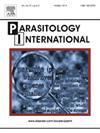Method for deletion of variant surface antigen genes at subtelomeric region of Plasmodium falciparum
IF 1.5
4区 医学
Q3 PARASITOLOGY
引用次数: 0
Abstract
Plasmodium falciparum expresses variant surface antigens (VSAs), including PfEMP1, RIFIN, and STEVOR, SURFIN on the surface of infected red blood cells. These antigens interact with host receptors on vascular endothelial and immune cells, contributing to both parasite pathogenicity and immune evasion. VSAs are encoded by large multigene families, comprising dozens to hundreds of genes located primarily in heterochromatic regions such as subtelomeric domains, which are notoriously refractory to genetic manipulation. In addition, since P. falciparum parasites undergo antigenic variation by randomly switching VSA expression, it is challenging to use parasites that stably express target VSAs for experimental purposes. As a result, functional characterization of these VSAs has been limited, despite their well-established clinical significance. Here, we present a novel method for targeted deletion of subtelomeric regions in P. falciparum chromosomes by combining the heterochromatin-accessible AsCas12a-UL nuclease with telomere healing. Using this approach, we successfully deleted both subtelomeric regions of chromosome 2. Furthermore, we achieved simultaneous removal of up to seven subtelomeric regions using tandemly arrayed crRNAs, with an efficiency exceeding 85 %. This method provides a powerful tool for generating VSA-null parasites, facilitating precise genetic dissection of individual VSA gene families and their roles in host–parasite interactions.

恶性疟原虫亚端粒区表面抗原变异基因的缺失方法
恶性疟原虫在被感染的红细胞表面表达变异表面抗原(VSAs),包括PfEMP1、RIFIN和STEVOR、SURFIN。这些抗原与血管内皮细胞和免疫细胞上的宿主受体相互作用,有助于寄生虫的致病性和免疫逃避。VSAs由大型多基因家族编码,包括主要位于异染色质区域(如亚端粒结构域)的数十至数百个基因,这些基因难以进行遗传操作。此外,由于恶性疟原虫通过随机切换VSA表达而发生抗原变异,因此使用稳定表达目标VSA的寄生虫进行实验具有挑战性。因此,尽管这些vsa具有良好的临床意义,但其功能表征仍受到限制。在这里,我们提出了一种将异染色质可及的AsCas12a-UL核酸酶与端粒愈合相结合的新方法,用于靶向删除恶性疟原虫染色体的亚端粒区域。利用这种方法,我们成功地删除了2号染色体的两个亚端粒区域。此外,我们使用串联排列的crrna实现了多达7个亚端粒区域的同时去除,效率超过85%。该方法为生成无VSA的寄生虫提供了强大的工具,有助于对VSA基因家族及其在宿主-寄生虫相互作用中的作用进行精确的遗传解剖。
本文章由计算机程序翻译,如有差异,请以英文原文为准。
求助全文
约1分钟内获得全文
求助全文
来源期刊

Parasitology International
医学-寄生虫学
CiteScore
4.00
自引率
10.50%
发文量
140
审稿时长
61 days
期刊介绍:
Parasitology International provides a medium for rapid, carefully reviewed publications in the field of human and animal parasitology. Original papers, rapid communications, and original case reports from all geographical areas and covering all parasitological disciplines, including structure, immunology, cell biology, biochemistry, molecular biology, and systematics, may be submitted. Reviews on recent developments are invited regularly, but suggestions in this respect are welcome. Letters to the Editor commenting on any aspect of the Journal are also welcome.
 求助内容:
求助内容: 应助结果提醒方式:
应助结果提醒方式:


